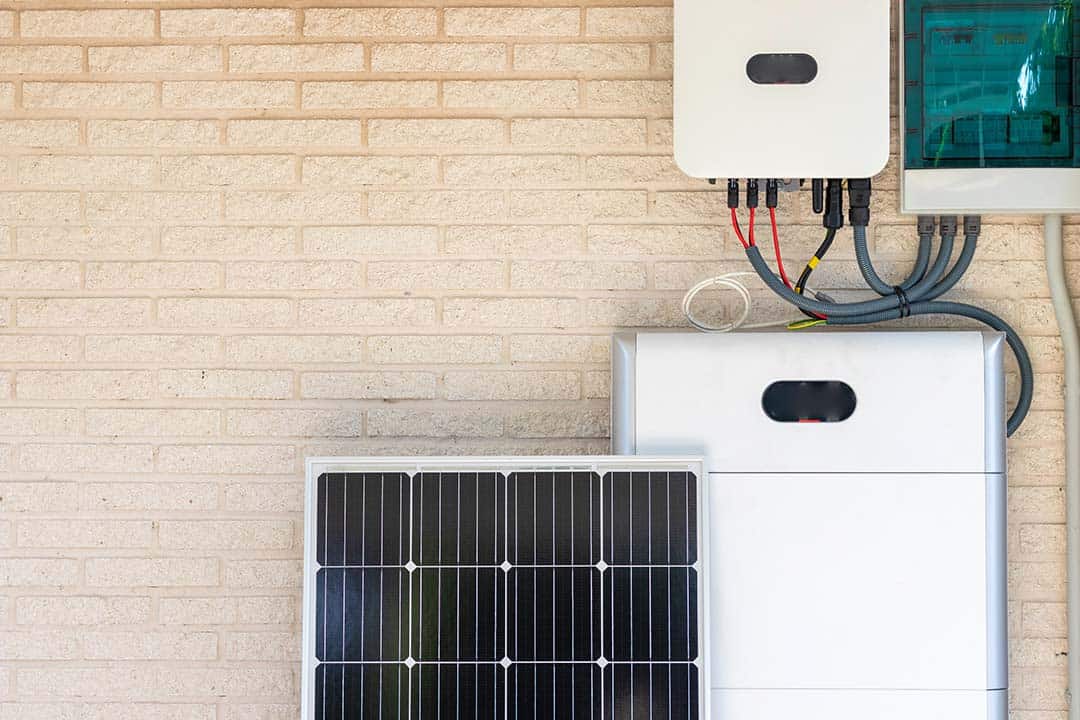Do you know one of the thousands of Iowa homeowners who have already gone solar? According to the Solar Energy Industries Association, Iowa has already installed enough solar to power 61,863 homes!
As solar becomes a more common power source, homeowners considering the switch have questions about many aspects of solar.
Questions like what‘s the benefit of an on-grid system? What happens with solar when the power goes out?
Keep reading as we cover how grid tied solar and net metering works versus solar with a battery bank.
Grid-Tied Solar & Net Metering
Grid-tied solar systems are still connected to your local electricity grid, and work without requiring any battery back-up for when you need more energy than your system can produce. They’re also one of the most common types of solar systems across the US.
A grid-tied system works by sending the excess energy produced by your system back through the grid. For every kilowatt hour of energy you send back, you receive a credit on your account.
During times when your home needs energy the solar panels can’t produce, like during a winter storm, you have those credits to help you out.
Net metering works like an on-grid battery bank for solar by accumulating your excess energy like a battery bank would.
But why is this process referred to as net metering? When you go solar, a second meter called the net meter is connected to your home. The net meter allows Hawkeye state homeowners with solar panels to receive a credit for the extra energy their solar produces.
That excess energy is recorded by your net meter as it’s sent back onto the grid.
MidAmerican and Alliant both handle net metering differently. MidAmerican bases it on your annual energy use. Alliant takes your overall consumption divided by the capacity of your system measured in kilowatt hours.
Either way, you’re gaining credits as your solar generates enough electricity to power your home and then some.
Homeowners go with grid tied solar because it’s an affordable way of switching to home solar without the extra expense of buying a battery backup.
Is a Battery Bank Worth It?
So if you can go solar and save with net metering, and have a way to pull energy back from the grid when you need it, why would any homeowner install a battery bank?
If you’re planning on living off-grid, or live in an area with regular power outages, then a battery bank may be the right fit for you. A battery bank can help you store your energy for access right at home. But so can a home with grid-tied solar and a generator back up.
Most homeowners will find a grid-tied system is the best investment given their energy needs and budget. Unless you plan on living far away from any neighbors and truly off-grid.
Why? Because battery banks have some major drawbacks you might not know about. Let’s break down the elements that make a battery bank less cost effective.
- High Cost: the average cost of a battery bank is regularly upwards of $6,000, and homes with higher energy usages can expect to pay roughly half the cost of their solar energy system for a battery bank.
- High Maintenance: depending on what type of batteries you use, you’ll need regularly rotate and maintenance your batteries to avoid uneven charging and decreased lifespan. A battery bank is another chore to add to your list, and introduces the (minor) risk of having a block of flammable material near or in your home.
- Issues with Legality: Whether or not you want a battery bank in your home might be a moot point. In some parts of the U.S. it’s illegal to allow rooftop solar to charge battery banks at home.
How to Choose Between Net Metering or Battery Bank
Now that you are more familiar with the way grid-tied solar and solar battery banks work, how do you decide which is best for you?
For the most affordable choice, grid-tied solar with net metering is your best option to maximize your savings. You’ll get the perk of having access to the energy excess your panels will produce without the hassle or cost of maintaining battery storage at home.
Battery banks are only necessary for homeowners who live off-grid, or experience serious and regular power outages. Homeowners could also consider a solar generator as their back up, which are generally about half the cost of a battery bank.
Between the high costs and the ongoing maintenance, the average homeowner won’t see the full return on their investment into a solar battery bank.
The vast majority of homeowners across Iowa will find grid-tied solar meets their needs. You can go solar, save, and still power your home with clean, renewable energy even in the middle of the night or a winter storm.
Solar with Net Metering is The Way to Go!
Ready to go solar and maximize your savings? Our local solar experts are here to help you own your power and help you save with grid-tied solar!
By taking advantage of Purelight’s zero down program homeowners can go solar for nothing out of pocket!
See if your roof qualifies for our $0 out of pocket solar today.





